ABA and SA Participate in the Regulation of Terpenoid Metabolic Flux Induced by Low-Temperature within Conyza blinii
Abstract
1. Introduction
2. Materials and Methods
2.1. Plant Materials
2.2. Low-Temperature Stress (LTS) Treatment
2.3. Treatment of Exogenous ABA, SA, and Their Inhibitors
2.4. Analysis of Chlorophyll and Carotenoid Content
2.5. Content Detection of Cellulose and Pectin
2.6. Glandular Trichome (GTs) and Deciduous Leaf Counting
2.7. Content Detection of Blinin and Oleanolic Acid
2.8. Content Detection of SA, ABA, IAA, GA3, ZT and BR
2.9. Screening and Expression Detection of ABA/SA Signal Transduction Pathway Genes
2.10. Statistical Analysis and Illustration
3. Results
3.1. The Change in the Basic Physiology of C. blinii during Nocturnal LTS
3.2. The Accumulation Mode of Oleanolic Acid and Blinin in C. blinii during Nocturnal LTS
3.3. The Phytohormone Fluctuations in C. blinii during Nocturnal LTS
3.4. The Correlation Analysis among Phytohormones, Oleanolic Acid and Blinin
3.5. Changes in Gene Expression of ABA and SA Signal Transduction Pathway in LTS
3.6. This Regulation Is Driven by Different Sources of LTS
4. Discussion
4.1. C. blinii Planned Serial and Positive Changes in Phytohormones under Nocturnal LTS
4.2. The Potential Crosstalk of ABA and SA When Subjected to LTS
4.3. LTS Might Only Drive Blinii Synthesis, but Simultaneously Drive Oleanolic Acid Synthesis and Degradation
5. Conclusions
Supplementary Materials
Author Contributions
Funding
Institutional Review Board Statement
Informed Consent Statement
Data Availability Statement
Acknowledgments
Conflicts of Interest
References
- Sheldon, C.C.; Finnegan, E.J.; Rouse, D.T.; Tadege, M.; Bagnall, D.J.; Helliwell, C.A.; Peacock, W.J.; Dennis, E.S. The control of flowering by vernalization. Curr. Opin. Plant Biol. 2000, 3, 418–422. [Google Scholar] [CrossRef] [PubMed]
- Bastow, R.; Mylne, J.S.; Lister, C.; Lippman, Z.; Martienssen, R.A.; Dean, C. Vernalization requires epigenetic silencing of FLC by histone methylation. Nature 2004, 427, 164–167. [Google Scholar] [CrossRef] [PubMed]
- Ishikawa, K.; Tateyama, M. Changes in hybridizable RNA in winter wheat embryos during germination and vernalization. Plant Cell Physiol. 1977, 18, 875–882. [Google Scholar] [CrossRef]
- Waadt, R.; Seller, C.A.; Hsu, P.K.; Takahashi, Y.; Munemasa, S.; Schroeder, J.I. Plant hormone regulation of abiotic stress responses. Nat. Rev. Mol. Cell Biol. 2022, 23, 680–694. [Google Scholar] [CrossRef] [PubMed]
- Castroverde, C.D.M.; Dina, D. Temperature regulation of plant hormone signaling during stress and development. J. Exp. Bot. 2021. [Google Scholar] [CrossRef]
- Zhang, H.; Zhao, Y.; Zhu, J.K. Thriving under Stress: How Plants Balance Growth and the Stress Response. Dev. Cell 2020, 55, 529–543. [Google Scholar] [CrossRef]
- Ding, Y.; Li, H.; Zhang, X.; Xie, Q.; Gong, Z.; Yang, S. OST1 Kinase Modulates Freezing Tolerance by Enhancing ICE1 Stability in Arabidopsis. Dev. Cell 2015, 32, 278–289. [Google Scholar] [CrossRef]
- Ding, Y.; Jia, Y.; Shi, Y.; Zhang, X.; Song, C.; Gong, Z.; Yang, S. OST1-mediated BTF3L phosphorylation positively regulates CBFs during plant cold responses. EMBO J. 2018, 37. [Google Scholar] [CrossRef]
- Lv, J.; Liu, J.; Ming, Y.; Shi, Y.; Song, C.; Gong, Z.; Yang, S.; Ding, Y. Reciprocal regulation between the negative regulator PP2CG1 phosphatase and the positive regulator OST1 kinase confers cold response in Arabidopsis. J. Integr. Plant Biol. 2021, 63, 1568–1587. [Google Scholar] [CrossRef]
- Kidokoro, S.; Shinozaki, K.; Yamaguchi-Shinozaki, K. Transcriptional regulatory network of plant cold-stress responses. Trends Plant Sci. 2022, 27, 922–935. [Google Scholar] [CrossRef]
- Wang, S.; Liang, W.; Yao, L.; Wang, J.; Gao, W. Effect of temperature on morphology, ginsenosides biosynthesis, functional genes, and transcriptional factors expression in Panax ginseng adventitious roots. J. Food Biochem. 2019, 43, e12794. [Google Scholar] [CrossRef]
- Vashisth, D.; Kumar, R.; Rastogi, S.; Patel, V.K.; Kalra, A.; Gupta, M.M.; Gupta, A.K.; Shasany, A.K. Transcriptome changes induced by abiotic stresses in Artemisia annua. Sci. Rep. 2018, 8, 3423. [Google Scholar] [CrossRef]
- Yang, L.; Zheng, Z.S.; Cheng, F.; Ruan, X.; Jiang, D.A.; Pan, C.D.; Wang, Q. Seasonal Dynamics of Metabolites in Needles of Taxus wallichiana var. mairei. Molecules 2016, 21, 1403. [Google Scholar] [CrossRef]
- Liu, P.; Zhou, L.; Su, Y.; Yan, S. Effects of Total Saponins from Conyza blinii on the Apoptosis of Hela Cells and SPC-A1 Cells. China Pharm. 2011, 22, 3288–3291. [Google Scholar]
- Liu, H.; Hu, C.; Sun, N.; Li, Y.; Man, S.; Liu, Z.; Diao, A.; Ma, L. A triterpenoidal saponin fraction of Conyza blinii H.Lév. is a dual-targeting autophagy inhibitor for HeLa cells. RSC Advances 2017, 7, 24291–24297. [Google Scholar] [CrossRef]
- Li, J.; Wang, Y.; Dong, Y.; Zhang, W.; Wang, D.; Bai, H.; Li, K.; Li, H.; Shi, L. Correction: The chromosome-based lavender genome provides new insights into Lamiaceae evolution and terpenoid biosynthesis. Hortic. Res. 2021, 8, 90. [Google Scholar] [CrossRef]
- Zheng, T.; Wang, M.; Zhan, J.; Sun, W.; Yang, Q.; Lin, Z.; Bu, T.; Tang, Z.; Li, C.; Yan, J.; et al. Ferrous iron-induced increases in capitate glandular trichome density and upregulation of CbHO-1 contributes to increases in blinin content in Conyza blinii. Planta 2020, 252, 81. [Google Scholar] [CrossRef]
- Yang, M.; Zheng, T.; Zhan, J.; Wang, M.; Sun, W.; Zhou, M.; Tang, Z.; Bu, T.; Li, Q.; Chen, H. Conyza blinii responds to the changes of exogenous iron through auxin-terpenoids metabolism pathway. J. Plant Interact. 2022, 17, 485–495. [Google Scholar] [CrossRef]
- Zhan, J. Effects of UV-B Radiation on Conzya blinii’s Trichome Density and Its Blinin Secretory. Master’s Thesis, Sichuan Agricultural University, Sichuan, China, 2020. [Google Scholar]
- Li, X.; La Motte, C.E.; Stewart, C.R.; Cloud, N.P.; Wear-Bagnall, S.; Jiang, C.-Z. Determination of IAA and ABA in the same plant sample by a widely applicable method using GC-MS with selected ion monitoring. J. Plant Growth Regul. 1992, 11, 55–65. [Google Scholar] [CrossRef]
- Hadi, S.; Swaleh Al-Khalifah, N.; Abdo Moslem, M. Hormonal Basis of ‘Shees’ Fruit Abnormality in Tissue Culture Derived Plants of Date Palm. Int. J. Agric. Biol. 2015, 17, 607–612. [Google Scholar] [CrossRef]
- Zhan, J.; Yang, Q.; Lin, Z.; Zheng, T.; Wang, M.; Sun, W.; Bu, T.; Tang, Z.; Li, C.; Han, X.; et al. Enhanced antioxidant capacity and upregulated transporter genes contribute to the UV-B-induced increase in blinin in Conyza blinii. Environ. Sci. Pollut. Res. Int. 2021, 28, 13275–13287. [Google Scholar] [CrossRef] [PubMed]
- Zheng, T.; Zhan, J.; Wang, M.; Sun, W.; Yan, J.; Shan, Z.; Chen, H. Fe induces a dynamic and biased allocation of material flux within terpenoid metabolism controlled by CbNudix in Conyza blinii. Plant Soil 2021, 467, 421–436. [Google Scholar] [CrossRef]
- Sun, W.-J.; Zhan, J.-Y.; Zheng, T.-R.; Sun, R.; Wang, T.; Tang, Z.-Z.; Bu, T.-L.; Li, C.-L.; Wu, Q.; Chen, H. The jasmonate-responsive transcription factor CbWRKY24 regulates terpenoid biosynthetic genes to promote saponin biosynthesis in Conyza blinii H. Lév. J. Genet. 2018, 97, 1379–1388. [Google Scholar] [CrossRef] [PubMed]
- Shi, Y.; Ding, Y.; Yang, S. Cold signal transduction and its interplay with phytohormones during cold acclimation. Plant Cell Physiol. 2015, 56, 7–15. [Google Scholar] [CrossRef]
- Zhang, R.; Wu, X.; Ma, B.; Chen, S.; Wang, X.; Gao, W.; Huang, L. Efects of diferent concentration of ABA on terpenoid in cell of radix folium seu flos Tripterygii Wilfordii. World Chin. Med. 2018, 13, 264–270. [Google Scholar] [CrossRef]
- Olate, E.; Jiménez-Gómez, J.M.; Holuigue, L.; Salinas, J. NPR1 mediates a novel regulatory pathway in cold acclimation by interacting with HSFA1 factors. Nat. Plants 2018, 4, 811–823. [Google Scholar] [CrossRef]
- Wang, Q.; Liu, G.; Su, L. Effects of Salicylic Acid and Methyl Jasmonate on Expression of Terpenoid Secondary Metabolites Related Genes of Miniature Rose. Mol. Plant Breed. 2020, 3, 797–803. [Google Scholar] [CrossRef]
- Lv, Z. The Study of Regulating Artemisinin Biosynthesis in Artemisia annua by Branch Pathway Blocking and Salicylic Acid. Ph.D. Thesis, Shanghai Jiao Tong University, Shanghai, China, 2016. [Google Scholar]
- Flors, V.; Ton, J.; van Doorn, R.; Jakab, G.; Garcia-Agustin, P.; Mauch-Mani, B. Interplay between JA, SA and ABA signalling during basal and induced resistance against Pseudomonas syringae and Alternaria brassicicola. Plant J. 2008, 54, 81–92. [Google Scholar] [CrossRef]
- Checker, V.G.; Kushwaha, H.R.; Kumari, P.; Yadav, S. Role of Phytohormones in Plant Defense: Signaling and Cross Talk. In Molecular Aspects of Plant-Pathogen Interaction; Springer: Berlin/Heidelberg, Germany, 2018; pp. 159–184. [Google Scholar]
- Horvath, E.; Csiszar, J.; Galle, A.; Poor, P.; Szepesi, A.; Tari, I. Hardening with salicylic acid induces concentration-dependent changes in abscisic acid biosynthesis of tomato under salt stress. J. Plant Physiol. 2015, 183, 54–63. [Google Scholar] [CrossRef]
- Yasuda, M.; Ishikawa, A.; Jikumaru, Y.; Seki, M.; Umezawa, T.; Asami, T.; Maruyama-Nakashita, A.; Kudo, T.; Shinozaki, K.; Yoshida, S.; et al. Antagonistic interaction between systemic acquired resistance and the abscisic acid-mediated abiotic stress response in Arabidopsis. Plant Cell 2008, 20, 1678–1692. [Google Scholar] [CrossRef]
- Yu, H.; Jiang, C.; Wang, C.; Lin, Y.; Ji, Y.; Li, W. Physiological Response of High Quality Forage Desmodium intortum to Low Temperature Stress and Rapid Identification of Its Cold Tolerance. J. Trop. Subtrop. Bot. 2019, 27, 649–658. [Google Scholar] [CrossRef]
- Tang, X.-y.; He, X.; Zhang, M.; Liu, Y.-l.; Ye, Y. Synthesis of sapogenin derivatives and their antioxidant activities. J. Chem. Eng. Chin. Univ. 2021, 35, 882–890. [Google Scholar] [CrossRef]
- Su, L.; Liu, H.; Liu, L.; Huang, H.; Xi, J.; Liu, X. Research on antioxidation of Panax notoginseng saponins in rats of chronic aristolochic acid nephropathy. J. Pharm. Res. 2011, 30, 190–191. [Google Scholar] [CrossRef]
- Lan, R.; Liang, Y. Effects of Ginsenoside CK on Anti-fatigue and Oxidative Stress of Skeletal Muscle in Exhaustive Swimming Rats. J. Yunnan Agric. Univ. Nat. Sci. 2022, 37, 491–496. [Google Scholar] [CrossRef]
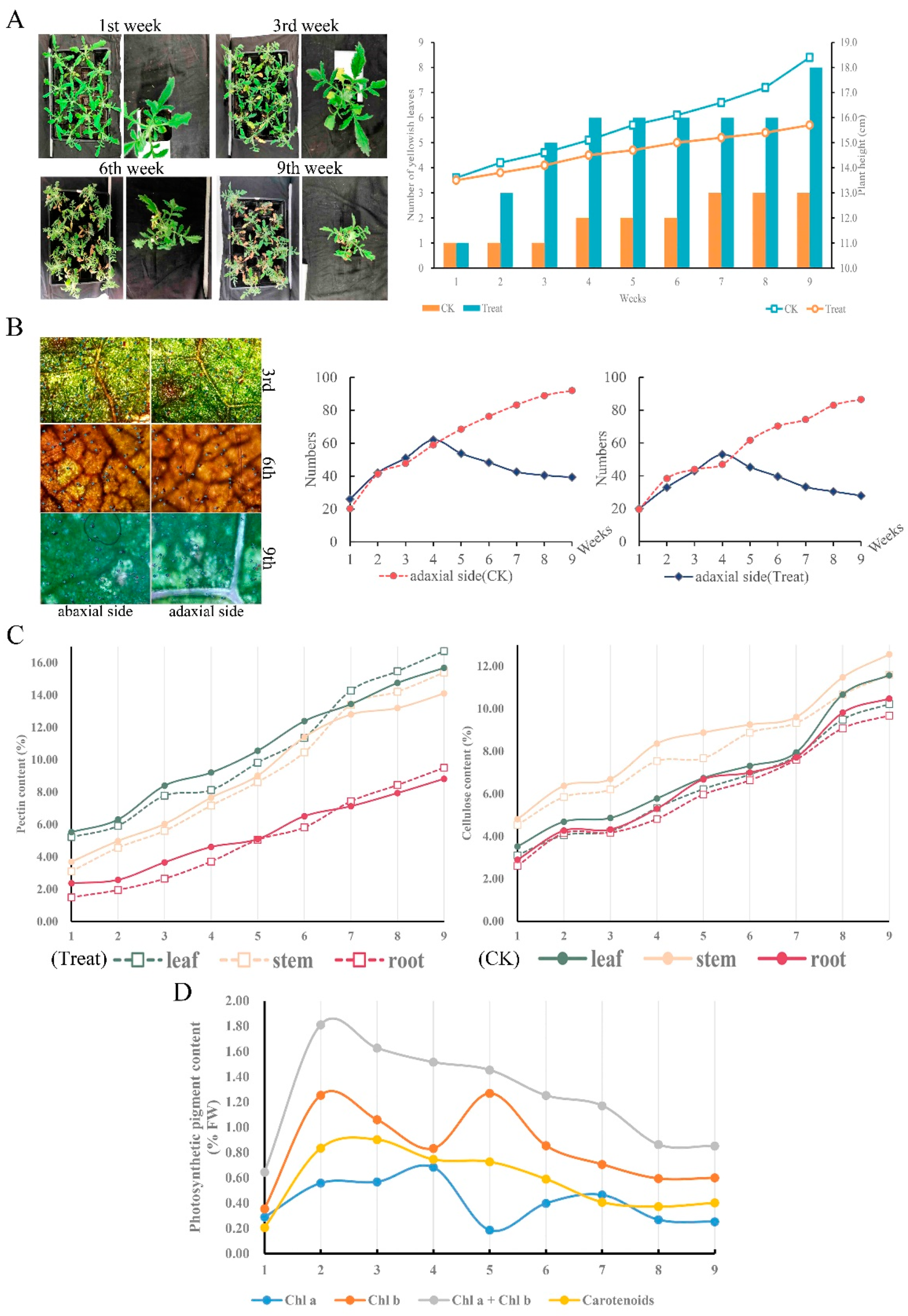
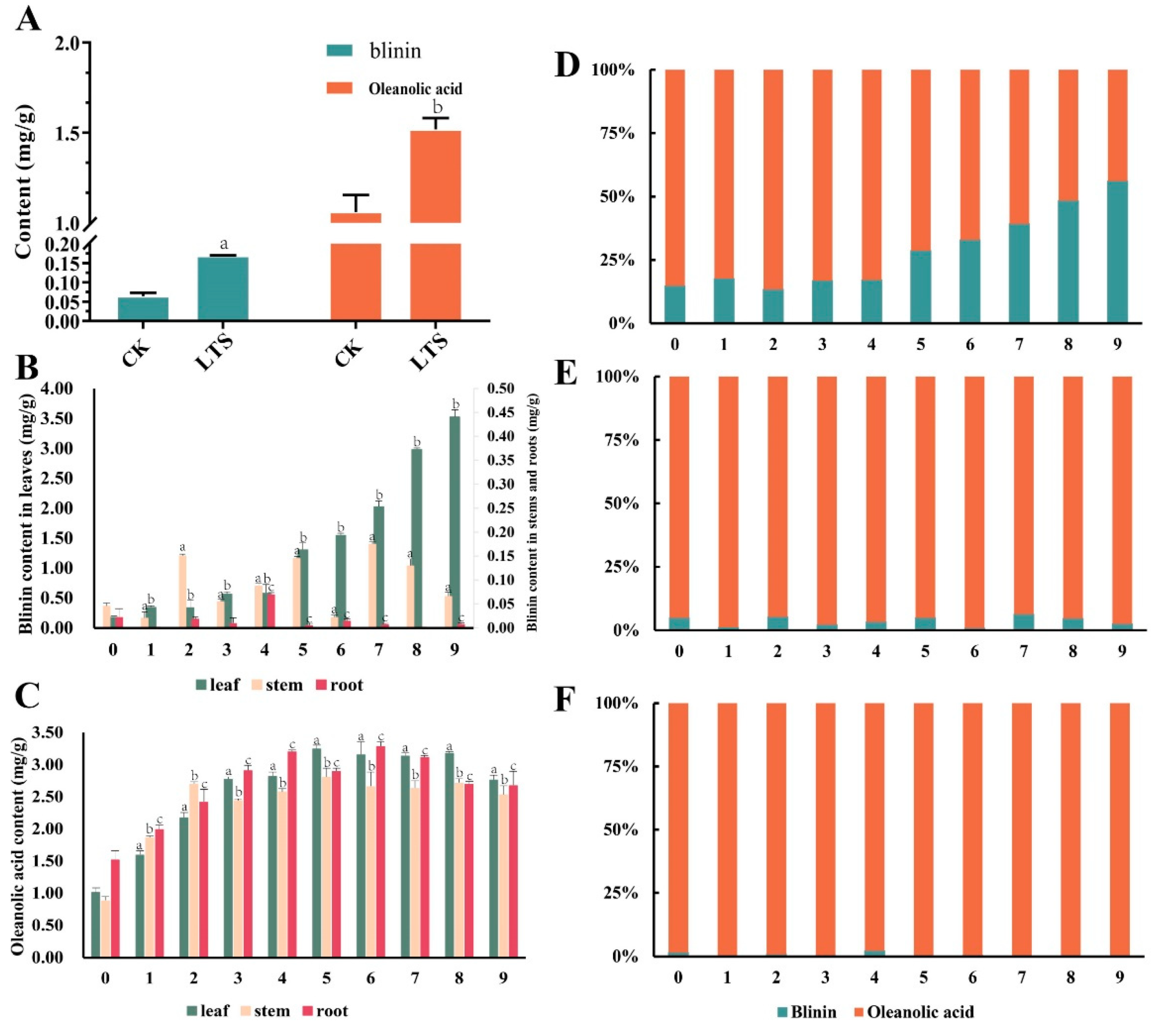
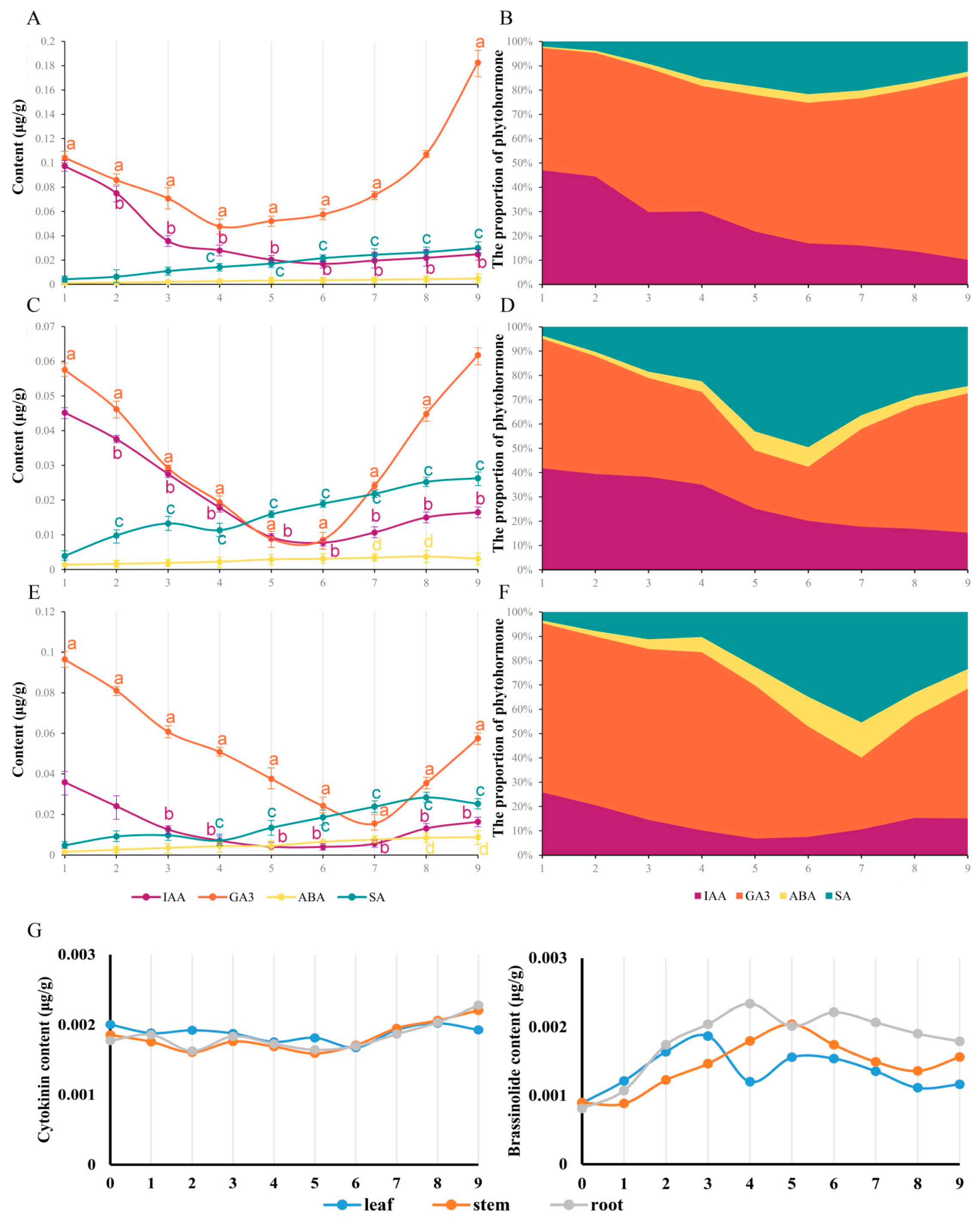

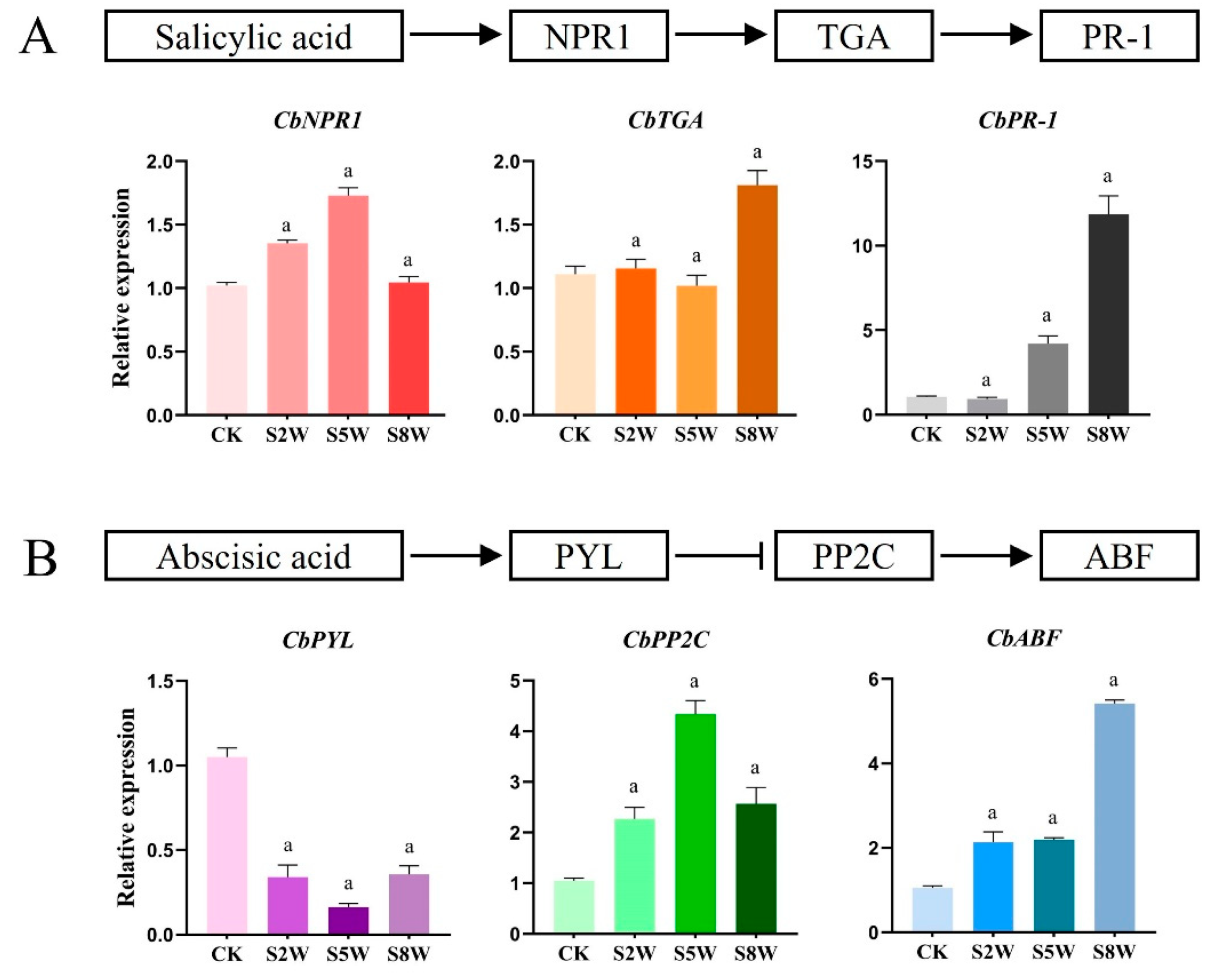

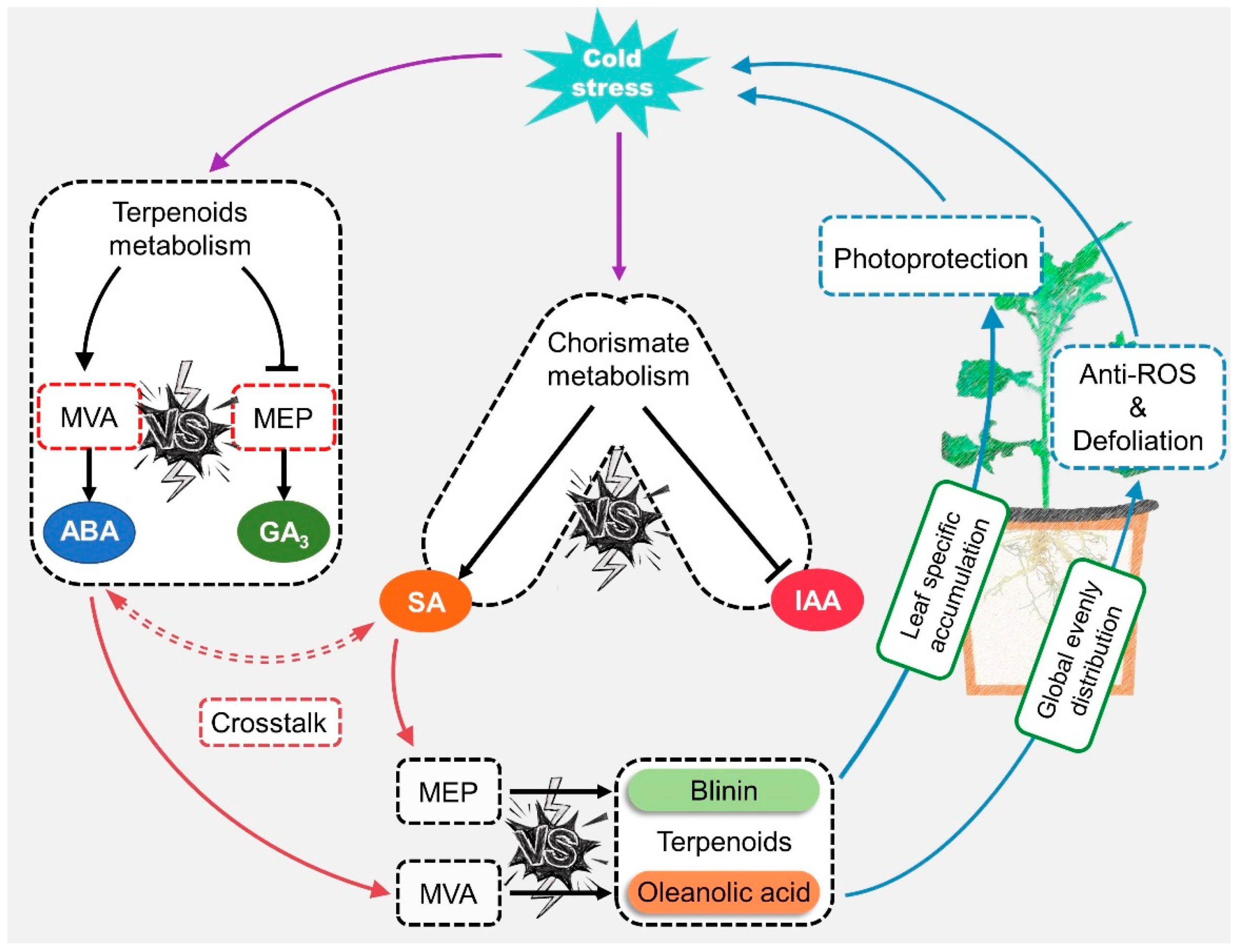
Disclaimer/Publisher’s Note: The statements, opinions and data contained in all publications are solely those of the individual author(s) and contributor(s) and not of MDPI and/or the editor(s). MDPI and/or the editor(s) disclaim responsibility for any injury to people or property resulting from any ideas, methods, instructions or products referred to in the content. |
© 2023 by the authors. Licensee MDPI, Basel, Switzerland. This article is an open access article distributed under the terms and conditions of the Creative Commons Attribution (CC BY) license (https://creativecommons.org/licenses/by/4.0/).
Share and Cite
Yang, M.; Wang, M.; Zhou, M.; Zhang, Y.; Yu, K.; Wang, T.; Bu, T.; Tang, Z.; Zheng, T.; Chen, H. ABA and SA Participate in the Regulation of Terpenoid Metabolic Flux Induced by Low-Temperature within Conyza blinii. Life 2023, 13, 371. https://doi.org/10.3390/life13020371
Yang M, Wang M, Zhou M, Zhang Y, Yu K, Wang T, Bu T, Tang Z, Zheng T, Chen H. ABA and SA Participate in the Regulation of Terpenoid Metabolic Flux Induced by Low-Temperature within Conyza blinii. Life. 2023; 13(2):371. https://doi.org/10.3390/life13020371
Chicago/Turabian StyleYang, Ming, Maojia Wang, Ming Zhou, Yifu Zhang, Keliang Yu, Tao Wang, Tongliang Bu, Zizhong Tang, Tianrun Zheng, and Hui Chen. 2023. "ABA and SA Participate in the Regulation of Terpenoid Metabolic Flux Induced by Low-Temperature within Conyza blinii" Life 13, no. 2: 371. https://doi.org/10.3390/life13020371
APA StyleYang, M., Wang, M., Zhou, M., Zhang, Y., Yu, K., Wang, T., Bu, T., Tang, Z., Zheng, T., & Chen, H. (2023). ABA and SA Participate in the Regulation of Terpenoid Metabolic Flux Induced by Low-Temperature within Conyza blinii. Life, 13(2), 371. https://doi.org/10.3390/life13020371






